3D scanners usually need a product to be placed on a rotating pad with sensors located no more than a few inches away, but that kind of approach will never work for items and places out in the real world. Fortunately, NIST has the solution.
NIST stands for the National Institute of Standards and Technology, a federal technology agency that works with industry to develop and apply technology, measurements, and standards.
What the researchers at NIST have managed to create is an imaging system that can scan things from a distance of 10.5 meters / 34 feet with such precision that even rough surfaces can be accurately depicted.
More specifically, when a rough surface is being surveyed, even light reflected in many directions can be determined, with an accuracy of 10 micrometers. All in half a millisecond if you can believe it.
The new NIST 3D imaging system
It can produce a 3D image containing 1 million pixels in less than 8 minutes and a half. All the while, nothing in the technology is harmful to humans. Even the laser has a power of just 9 milliwats, which is safe for the human eye to behold at the instrument's infrared wavelength.
That makes the NIST 3D mapping system qualify as a form of laser detection and ranging (LADAR), although one that has better than average capability of detecting light.
In fact, even weak reflected light is captured, thanks to frequency combs, tools that precisely measure light frequencies, and because of that, are able to continuously calibrate the laser in the imaging system.
Indeed, the laser constantly sweeps across a band of frequencies, combing the initial output with the reflected light and producing “beat” signals that later are converted into voltage and analyzed by a DSP (digital signal processor).
The resulting time delay data is then used to calculate distances. All this is different from normal LADAR systems, which usually measure distance based on the round-trip flight time of laser light, which is detected by a sensor after being deflected by the target.
So far, demos have shown the system capable of scanning footprints in soil, plants (cactus with individual spines), and a motorcycle piston (a complex mechanical device).
Possible uses for NIST's 3D scanner
Forensics is one thing, as it can detect footprints in dirt and various other evidence. Say goodbye to plaster casts used to record impression evidence.
And since the whole device is just about the size of a desktop (with plans to be converted into a portable form), it can become standard equipment in police stations, investigation departments, hospitals, etc.

 14 DAY TRIAL //
14 DAY TRIAL //